The winter holidays approach us quickly now, the Times of the Great Feasts, starting with Thanksgiving on November 25. For many this will be the first time to participate in a large gathering since the start of the pandemic in early 2020, which means a lot of hosts and hostesses will be unearthing the good stuff to celebrate. So after all this time, it’s worth mentioning a few things to guide the preparation.
Get started now. Truly, it will save you a lot of heartache if you know that you have what you need where you need it beforehand, so that you can respond with greater Perfect Propriety to the last-minute things that always happen. As Dear Mother used to say, “An ounce of prevention is worth a pound of cure.”
Inventory what you have based on the number of people coming. While the Great Feasts in America are often a comfortable combination of formal tables and casual clothes, the table can’t be set too casually. Count each element of the your table settings — water and wine glasses, necessary china and silver for each course — so that each person has what they need. Assign chipped or otherwise damaged pieces to your place setting. It’s not unusual, and quite proper, to fill in from whatever you have in the house to accommodate all your guests. For these Great Feasts, everyone understands, and it isn’t as though it was a state dinner.
Polish the silver. Emily Post Herself always said “Have silver that shines or none at all!” And she meant business. Tarnished silver looks like it might not actually be clean, and you don’t want your company to feel they are dining at an unsanitary table. It’s best to bring out the silver a couple weeks in advance so you have plenty of time, if needed. But usually properly stored silver just needs a glance for reassurance, with only a few pieces in need of serious polishing.
Mitigate possible damage. Etiquetteer will back you up if you prefer to serve children on paper plates, etc. especially children under, say ten years of age. Table linens always seem to be most at risk during the Great Feasts. Along with childhood table manners, both red wine and cranberry sauce leave indelible memories on white damask. Etiquetteer has two possible solutions for Table Linen Protection. The first: put sheet glass over your tabletop. Admittedly this is an extreme solution with its own risks, but if Elsie de Wolfe could get away with it in the private dining rooms at the Colony Club, Etiquetteer sees no reason for us not to attempt it at home. The second solution is to put a placemat atop the tablecloth at each place setting. There are pros and cons to this, too, and traditionalists might start howling in rage that it’s even suggested. But Etiquetteer cannot find a specific prohibition against it any of the standard works, so if placemats will help you feel better about using an heirloom tablecloth, have at it. Just make sure everything coordinates.
Finally, accept that damage may happen. Etiquetteer can’t help but remember Hepzibah Pyncheon getting out the old Chinese teacups when cousin Phoebe came to visit*. “Your great-great-great-great-grandmother had these cups, when she was married,” said Hepzibah to Phœbe. “. . . They were almost the first teacups ever seen in the colony; and if one of them were to be broken, my heart would break with it. But it is nonsense to speak so about a brittle teacup, when I remember what my heart has gone through without breaking.” We all care about our Good Stuff, but really dahlings, life is for living. If someone breaks a glass or spills the entire gravy boat on the tablecloth, these are just sacrifices on the altar of Hospitality. And if you can’t accept the risk, then Etiquetteer can only consign you to “the seasonless world where you shall laugh, but not all of your laughter, and weep, but not all of your tears**.”
Etiquetteer wishes you joy in the preparation, execution, and fellowship of whatever Great Feast might be in store for you.
*In Nathaniel Hawthorne’s The House of the Seven Gables, of course.
**From Kahlil Gibran’s “On Love” in The Prophet.
































